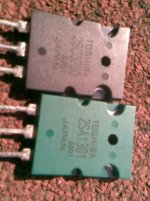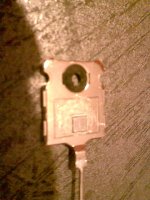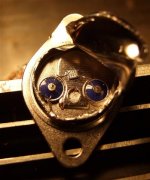/OT
If you need more than 10, you better have an armed friend, or an escape route.
Back on topic: No, I certainly don't recommend doing business with Match-a-Knob. I got perhaps a dozen original, good transistors, and several dozen bad fakes (some with two dies...had pics around here at one time). I gave up on sourcing out-of-production transistors right about then.
If you need more than 10, you better have an armed friend, or an escape route.

Back on topic: No, I certainly don't recommend doing business with Match-a-Knob. I got perhaps a dozen original, good transistors, and several dozen bad fakes (some with two dies...had pics around here at one time). I gave up on sourcing out-of-production transistors right about then.
Are they real or fakes? I bought them in local shop couple months ago. I measured them with simple multimeter, and beta for one of them was about 40 - little too low. I've destroyed one, and die is 4x4.5mm (need daylight to make photo, so i'll try post it tomorrow).
Attachments
a few pages back, there's a pic of a pair of C5200's which look real. i'm beginning to make a list of the date code styles different manufacturers use. i'm getting my info either from data sheets when available, or from known original devices when i can find them. Toshiba uses a dot and two alphanumerics for their date code on the right side under the part number. so since it doesn't have a toshiba date code, the devices in your pic are fakes based on the date code characteristics. toshiba also has two beta ranges in their data sheet, R and O. since the beta range designator is not on your devices, or even the ones in the pic a few pages back, they are most likely fakes (yours and the ones a few pages back.)
Usually the die doesn't make it intact when taking apart a real TO-247/TO-264. Bash the case apart and the die comes out in pieces if the passivation is worth anything. And I haven't seen real PNPs in green packages since since the early days of white silk-screened logos (with "Toshiba" in the old script font).
i just downloaded Toshiba's Semiconductor Reliability Handbook. on pg 20 of chapter 1, they show the two date coding schemes they have in use, and i will fill in a small tidbit of info from actually looking at real toshiba devices. the two date coding schemes are the standard 4 digit one YYWW (year and week) and an abbreviated one using YM (last digit of the year, and a letter from A to L for the month). now for the undocumented tidbit.... they put a dot before the abbreviated date code (one up high like a degree(temp) mark). the date code is on the right hand side below the part number. the devices shown above have an S at the beginning of the date code, which is a bogus date code.
like i said, i have begun compiling (direct from manufacturer's publications where possible) the various date and lot code styles that they use to track reliability data. some of these markings are also logos, factory codes and such imprinted in the mold mark dimples (with sanken devices, the presence of an SK in the dimple above the collector lead actually indicates that it is a fake). from known good and original samples of sanken devices, i have found that sanken hasn't used an SK logo in the dimple at least as far back as 2005.
like i said, i have begun compiling (direct from manufacturer's publications where possible) the various date and lot code styles that they use to track reliability data. some of these markings are also logos, factory codes and such imprinted in the mold mark dimples (with sanken devices, the presence of an SK in the dimple above the collector lead actually indicates that it is a fake). from known good and original samples of sanken devices, i have found that sanken hasn't used an SK logo in the dimple at least as far back as 2005.
Hello friend,i have some issue like yours,everybody point in oscillation direction,after check that,
i go hard and open an original device (bad one) and compare with the ones i bought,of course i was disappointed, the new ones look smaler the leads are thin and have less dissipation area, and dont work ,fail as soon as i test hard...
Do the "open test"and compare (size area of the chip,leads etc) before go crazy...
i go hard and open an original device (bad one) and compare with the ones i bought,of course i was disappointed, the new ones look smaler the leads are thin and have less dissipation area, and dont work ,fail as soon as i test hard...
Do the "open test"and compare (size area of the chip,leads etc) before go crazy...
unfortunately ST almost invites counterfeiting, since they use silver paint on the top of their TO-3 cans and then prints their logo on top of it. the only real good way to check the transistors non-destructively is the C-E and B-C capacitance, and compare against known good ones (like the RCA devices you have). capacitance is somewhat proportional to die size.
hi,
i have a blown RCA somewhere from some time ago, i'll try to clean it up as good as i can and do some size comparisons.
oscillation is a very good point, but since they've blown so far in the very milisecond i connect vsupply i don't suspect that's the problem. circuit layout is exactly the same betwee channels, as is dc supply. i've switched supplys to double check and the RCA channel keeps working.
i'll try and build a low-voltage (<12v), medium current lamp switch or something like that with one ST , i sadly don't have a capacitance meter.
, i sadly don't have a capacitance meter.
i've bought them from thaishopetc @ ebay, not baco army goods.
i have a blown RCA somewhere from some time ago, i'll try to clean it up as good as i can and do some size comparisons.
oscillation is a very good point, but since they've blown so far in the very milisecond i connect vsupply i don't suspect that's the problem. circuit layout is exactly the same betwee channels, as is dc supply. i've switched supplys to double check and the RCA channel keeps working.
i'll try and build a low-voltage (<12v), medium current lamp switch or something like that with one ST
i've bought them from thaishopetc @ ebay, not baco army goods.
also, i've never seen 3055's with the large diameter pins.... 3055's always seem to have the standard pins. can you get MJ15024's? same beta range, better Ft (3 or 4Mhz) and 250V.
i've learned to buy my semis from reputable distributors. they may cost a little more up front, but i know what i'm getting. it's actually cheaper, considering that by the time you figure out the 3 or 4 transistors you blew up are fakes, they cost you as much as the 1 good one you wanted. then you have to find one from a better source and pay for the part and shipping all over again. when i'm doing a repair, discovering a fake also costs in client satisfaction, since it's extra time to get the right part.
i've learned to buy my semis from reputable distributors. they may cost a little more up front, but i know what i'm getting. it's actually cheaper, considering that by the time you figure out the 3 or 4 transistors you blew up are fakes, they cost you as much as the 1 good one you wanted. then you have to find one from a better source and pay for the part and shipping all over again. when i'm doing a repair, discovering a fake also costs in client satisfaction, since it's extra time to get the right part.
hi all,
i've sent the ebayshop owner an email explaining the situation. he assured me that they were from ST.
so as a final test i took out all RCA's from the working channel and replaced them with ST's. result: 4 blown ST's, driver transistors (BD140/139) also blown.
put back the original RCA's, new drivers and the channel works perfectly again.
interresting detail: the blown ST's all measure shorted between E-C/E-C but OK (~0.5V - ~0.6V in diode test) between B-E, B-C.
i'm not sure what it means, but normally everything's totally shorted or open, not normal diode values..
i'll order new ones (or no 3055's, but i wanted that for vintage's sake ) somewhere else. i've recieved a PM with advice to sample them at OnSemi.
) somewhere else. i've recieved a PM with advice to sample them at OnSemi.
thank you all very much for your help. i'll check this topic on regular base
i've sent the ebayshop owner an email explaining the situation. he assured me that they were from ST.
so as a final test i took out all RCA's from the working channel and replaced them with ST's. result: 4 blown ST's, driver transistors (BD140/139) also blown.
put back the original RCA's, new drivers and the channel works perfectly again.
interresting detail: the blown ST's all measure shorted between E-C/E-C but OK (~0.5V - ~0.6V in diode test) between B-E, B-C.
i'm not sure what it means, but normally everything's totally shorted or open, not normal diode values..
i'll order new ones (or no 3055's, but i wanted that for vintage's sake
thank you all very much for your help. i'll check this topic on regular base
I just bought some B1647's, they look a bit fishy to me. A real one is shown (bent leads):

back
crack?
real one
The suspects:
http://www.mustangmods.com/ims/u/1363/13725/284881.jpg
http://www.mustangmods.com/ims/u/1363/13725/284882.jpg
http://www.mustangmods.com/ims/u/1363/13725/284883.jpg
Any comments?

back
crack?
real one
The suspects:
http://www.mustangmods.com/ims/u/1363/13725/284881.jpg
http://www.mustangmods.com/ims/u/1363/13725/284882.jpg
http://www.mustangmods.com/ims/u/1363/13725/284883.jpg
Any comments?
the one you have labeled real is a real one. two of the fakes show signs of the face being sandpapered, as well as the SK in the dimple above the collector lead. and are definitely fakes. the other one has the same date code and beta code as the fakes, and it;s printed exactly the same way. notice the spacing and centering of the code groups. this makes the third one a fake as well, but the base device used to make this fake came from a different source than the other two fakes, it's possibly even a genuine sanken device, but the printing has been altered and printed exactly like the other fakes. the best test is to test the C-E and C-B capacitances and compare them to the good one.
the sandpaper evidence is the rounded edges of the dimples (sandpaper, wire wheel, buffing wheel, sandblasting box, there are several ways to remove the original numbers)
the sandpaper evidence is the rounded edges of the dimples (sandpaper, wire wheel, buffing wheel, sandblasting box, there are several ways to remove the original numbers)
unclejed613 said:the one you have labeled real is a real one. two of the fakes show signs of the face being sandpapered,
---
the sandpaper evidence is the rounded edges of the dimples (sandpaper, wire wheel, buffing wheel, sandblasting box, there are several ways to remove the original numbers)
Very interesting, uncleJed
So this is how they do it .. sandpaper or simlar to remove original label first
... then add the faked print

- Home
- Design & Build
- Parts
- My Transistors, original or copy?



 Is there anybody who knows where to buy REAL Toshiba transistors in Europe in small quntities. I am soooo tired of that Chinese junk sneaking in everywhere
Is there anybody who knows where to buy REAL Toshiba transistors in Europe in small quntities. I am soooo tired of that Chinese junk sneaking in everywhere